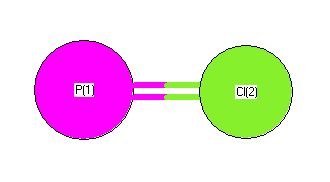Jump to
S2C1
Energy calculated at QCISD/6-31G*
| | hartrees |
|---|
| Energy at 0K | -800.422550 |
| Energy at 298.15K | -800.422802 |
| HF Energy | -800.197402 |
| Nuclear repulsion energy | 65.860942 |
The energy at 298.15K was derived from the energy at 0K
and an integrated heat capacity that used the calculated vibrational frequencies.
Geometric Data calculated at QCISD/6-31G*
Point Group is C∞v
Cartesians (Å)
| Atom |
x (Å) |
y (Å) |
z (Å) |
|---|
| P1 |
0.000 |
0.000 |
-1.088 |
| Cl2 |
0.000 |
0.000 |
0.960 |
Atom - Atom Distances (Å)
 More geometry information
More geometry information
Electronic energy levels
Electronic state
Charges, Dipole, Quadrupole and Polarizability
Jump to
S1C1
Energy calculated at QCISD/6-31G*
| | hartrees |
|---|
| Energy at 0K | -800.372610 |
| Energy at 298.15K | -800.372874 |
| Nuclear repulsion energy | 66.401797 |
The energy at 298.15K was derived from the energy at 0K
and an integrated heat capacity that used the calculated vibrational frequencies.
Geometric Data calculated at QCISD/6-31G*
Point Group is C∞v
Cartesians (Å)
| Atom |
x (Å) |
y (Å) |
z (Å) |
|---|
| P1 |
0.000 |
0.000 |
-1.080 |
| Cl2 |
0.000 |
0.000 |
0.953 |
Atom - Atom Distances (Å)
 More geometry information
More geometry information
Electronic energy levels
Electronic state
Charges, Dipole, Quadrupole and Polarizability
